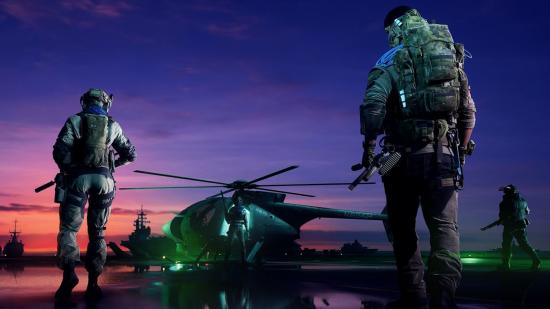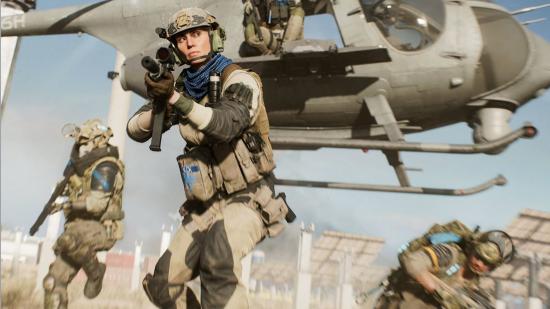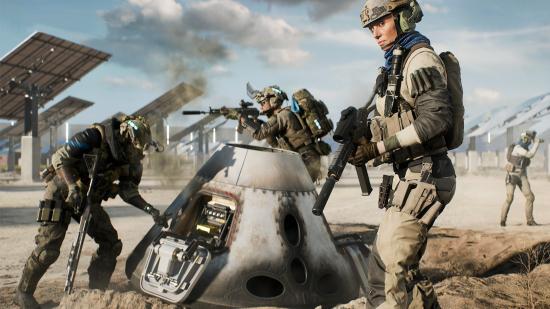Support for Battlefield 2042 Hazard Zone was discontinued in May 2022, with no new content added to the mode ever since. However, it is still playable.
Battlefield 2042’s Hazard Zone mode was a proper shakeup for Battlefield fans, even if it didn’t nail the landing. The high-stakes, retrieve-and-extract mode was billed as the ultimate test of strategy and tactics in Battlefield 2042, doing away with the large-scale battles for a smaller, more intense experience.
The overarching objective of Hazard Zone was to assemble a crack squad of four different specialists, drop into the map, locate and retrieve Data Drives from downed satellites, and then race to an extraction point to leave with the Data Drives.
While simple on paper, there were plenty of features, restrictions, and rules that made Hazard Zone a bit of a minefield to understand entirely. So, here’s all there is to know about Battlefield 2042’s Hazard Zone, a unique but flawed mode in one of the best FPS games series on PS5 and Xbox. Keep in mind that DICE stopped supporting Hazard Zone in May 2022, meaning there have not been any major updates or content additions ever since.
Battlefield 2042 Hazard Zone player count
Hazard Zone matches in Battlefield 2042 featured 32 players on Xbox Series XS, PS5, and PC, and 24 players on Xbox One and PS4.
There were, however, also AI-controlled Occupying Forces around the map that play into the PvPvE extraction setup of the mode. Given the lack of new content – and lack of content for the mode in general – it’s not easy to find a match of Hazard Zone today as very few players still engaging with it.
Battlefield 2042 Hazard Zone maps
Despite some hopes that Hazard Zone would have its own unique map or maps, the mode only ever used Battlefield 2042 All-Out Warfare maps instead.
The eight maps in Battlefield 2042 Hazard Zone are:
- Breakaway
- Discarded
- Hourglass
- Kaleidoscope
- Manifest
- Orbital
- Renewal
- Exposure
At launch, there were seven maps in Hazard Zone, all of which were versions of the traditional multiplayer mode maps. With support for Hazard Zone being cut off with Season 1, Exposure was the only map added to the mode post-release. In other words, there wasn’t much in the way of variety – which was part of the reason behind its failure.
These maps were scaled down to cater to Hazard Zone’s smaller player count.
Battlefield 2042 Hazard Zone explained
So, here’s our crack at explaining Hazard Zone and how a match would pan out.
Pre-match
Prior to a match of Hazard Zone, you assembled a four-person squad. In each squad, you had to have four different specialists. Before a match, you were also able to put together your loadout for the match. You could purchase weapons, gadgets, and Hazard Zone-specific Tactical Upgrades. These were special traits that gave you bonuses or buffs, like faster healing or increased ammo reserves.
The majority of gear and Tactical Upgrades you picked for your loadout had to be bought with Dark Market Credits, Hazard Zone’s currency – more on that later on though.
A Hazard Zone match saw all squads allocated a random spawn point on the map, which was shown to you beforehand in a pre-match briefing. Also in this briefing were the approximate locations of some downed satellites, which contained the precious commodity you were all fighting over: Data Drives.
These Data Drives were fiercely guarded by Occupying Forces, which were AI-controlled enemies. This was where you could expect to meet other enemy squads as well though, as they were also tracking down the satellites.
Finding Data Drives
As well as the satellites shown in your briefing, more fell from the sky throughout the match after you had spawned in. These contained double the amount of Data Drives, so were extra lucrative.
The location of downed satellites could be pinpointed by using a new gadget that was unique to Hazard Zone – the Intel Scanner. It was crucial that at least one person on your team had this gadget equipped.
Extraction
After retrieving some Data Drives, you then had to think about extraction. Only two extraction windows happened during a Hazard Zone match, and only one team could board the MV38 Condor and fly off into the sunset each time. That meant a maximum of two squads could ever make it out of a Hazard Zone game alive with their Data Drives. Those killed in action or those who failed to extract lost all the Data Drives they collected that match.
The two windows for extraction were time-gated and occured at random spots around the map. The first extraction period happened midway through a match, and the second happened at the end. Only one member of your team needed to successfully extract in order for the entire squad to keep their Data Drives.
Post-match
So, let’s say you negotiated a Hazard Zone map perfectly and extracted in time with a haul of Data Drives – what happened next? Well, the Data Drives could be sold in exchange for Dark Market Credits, which then helped you buy gear for your loadout for the next match. And that was basically the cycle of a Hazard Zone match.
Battlefield 2042 Hazard Zone reviving and respawning
In Hazard Zone, your life was far more precious than it was in other game modes. However, it wasn’t all ‘one strike and you’re out’. If you were brought down to zero health, you would enter a downed state, where you could crawl around to find safety and receive a revival from your squadmate. However, if you were finished off and completely eliminated, you would be sent to a spectator screen.
Again, that wasn’t the end of you though. Reinforcement Uplinks were essentially respawn stations scattered around the map and they revived a chosen teammate for you. There was also a Hazard Zone Tactical Upgrade that gave you one portable Reinforcement Uplink to resurrect a teammate on the fly.
That’s all there was to Battlefield 2042’s Hazard Zone, DICE’s take on the likes of Hunt Showdown and Escape From Tarkov, some of the best multiplayer games you can play.


